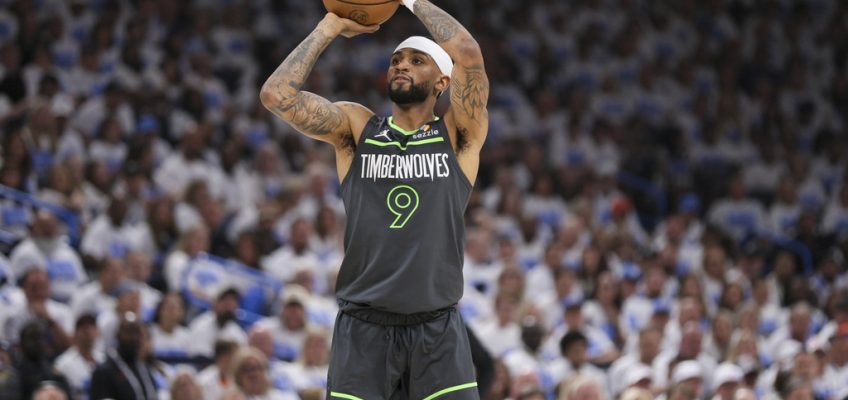OKLAHOMA CITY — Every time the mere thought of attacking the rack crossed Anthony Edwards’ mind in Game 1 of the Western Conference Finals on Tuesday, he saw four Thunder players between himself and the bucket.
Oklahoma City simply wasn’t going to make it an option in their 114-88, Game 1 victory at Paycom Center.
There’s a reason the Thunder allowed the third-fewest shots per game in the restricted area this season (21.6) and the lowest field goal percentage on such attempts (62.2%).
The initial line of defense, built out of an array of strong point-of-attack defenders, is so sturdy. Then there are the layers of defenders helping in from the perimeter, all before you reach the final line of defense, which is usually either Chet Holmgren or Isaiah Hartenstein waiting for you at the rim.
Edwards drove the ball just seven times in Game 1, per Second Spectrum tracking data. That’s a significant decrease from the 13 drives he’s averaging per game in these playoffs.
“They clogged the paint. That’s what they do,” Edwards said. “They don’t got much size down there, so they bank on us not making shots, I guess.”
It was a good bet in Game 1.
After Julius Randle went full flamethrower mode from deep in the first half on Tuesday, Minnesota combined to go just 5 for 23 from distance over the final two frames as Oklahoma City pulled away. Minnesota’s bench mob of Nickeil Alexander-Walker, Naz Reid and Donte DiVincenzo combined to go 5 for 28 from beyond the arc.
“Just missing a bunch of in-and-outs and all that good stuff,” Reid said.
The Wolves went 15 for 51 from beyond the arc on the evening, including going 8 for 30 on “wide open” shots, per NBA.com data.
“We were getting some good looks, and guys just weren’t knocking them down,” said Wolves guard Mike Conley, who went 1 for 5 from 3-point range. “We’ve got great shooters, guys who’ve done it all season and all playoffs. So, we have confidence in our guys. We have confidence that Julius, Ant, all the playmakers, will make the right reads and get guys good looks and we’ll find that hoop at some point.”
But part of that is dependent on the process of generating those 3-pointers. Oklahoma City surrendered a fair amount of 3-point attempts throughout the campaign (38.8 per game, 10th most in the NBA), but opponents shot a league-worst 34.2% on those looks.
That includes just 33% on “open” 3-pointers, the seventh-lowest mark in the NBA this season, and a league-low 37.2% on “wide open” attempts.
Because even your open looks against Oklahoma City are rarely produced within a comfortable rhythm. The Thunder’s pressure speeds teams up, much as it did to Minnesota on Tuesday.
“We had guys open at certain points within the offensive possession, and we just kind of made the pass two clicks late or just not on time or to the feet or just off balance,” Conley said. “That was leading to rushed opportunities.”
Which are less likely to fall. Timberwolves coach Chris Finch said Minnesota needs to do a better job establishing its repeatable formulas to generate good offense to establish a true rhythm.
“I thought for the most part we got some good looks, but I thought some were rushed,” Finch said. “Some were kind of from guys that were struggling to shoot, and sometimes they just want to see one go in. We definitely need to find a rhythm in this series. Every series is a little bit different in how people guard you and what not.
“I thought we came out and tried to play the same way we always did, and that wasn’t going to work tonight. We’ve got to figure out a different rhythm to play.”
That includes likely turning down the occasional decent look from distance to instead attack a closeout and get into the paint, or make the extra pass to turn down a good shot in favor of a great one.
Minnesota attempted 51 shots from beyond the arc Tuesday, compared to just 32 inside of it. Minnesota drove the ball 48 times, 13 fewer than the Thunder.
The Wolves scored 45 points via the 3-pointer in Game 1, and just 20 points in the paint. That’s a tough ratio to rely on in the postseason. It’s a formula that ultimately doomed the Celtics in the Eastern Conference semifinals against the Knicks.
At the same time, Donte DiVincenzo called it a “domino effect” for Minnesota if it can get a few outside shots to fall. He noted that can loosen the Thunder defense to create a few creases in which Edwards and Randle can attack.
Perhaps the 3-pointer is the chicken that can produce the egg that is better shots at the rim. Or maybe this will simply be a series in which Minnesota must rely on outside shooting variance to topple the best defense the NBA has produced in recent memory.
Conley is OK with that, as well. After all, Minnesota was fifth in 3-point makes (15) and fourth in percentage (37.7) in the NBA this season.
“So, I’m not overly concerned about us missing wide-open shots,” the veteran said. “I think as long as we get quality ones — we get the ones that are on time, on target — we’ve got some of the best shooters out there. So, I have confidence in us going forward.”
Related Articles
Frederick: We’ve always known Timberwolves and Thunder were ‘Next.’ But which one is now?
Anthony Edwards’ heroic shots get Timberwolves out of trouble
Mizutani: All aboard the Julius Randle bandwagon
From ‘Are we even going to have a chance to make the playoffs?’ to another West Finals for Timberwolves
Frederick: Timberwolves bypassed lottery balls in 2021, are better for it


Leave a Reply